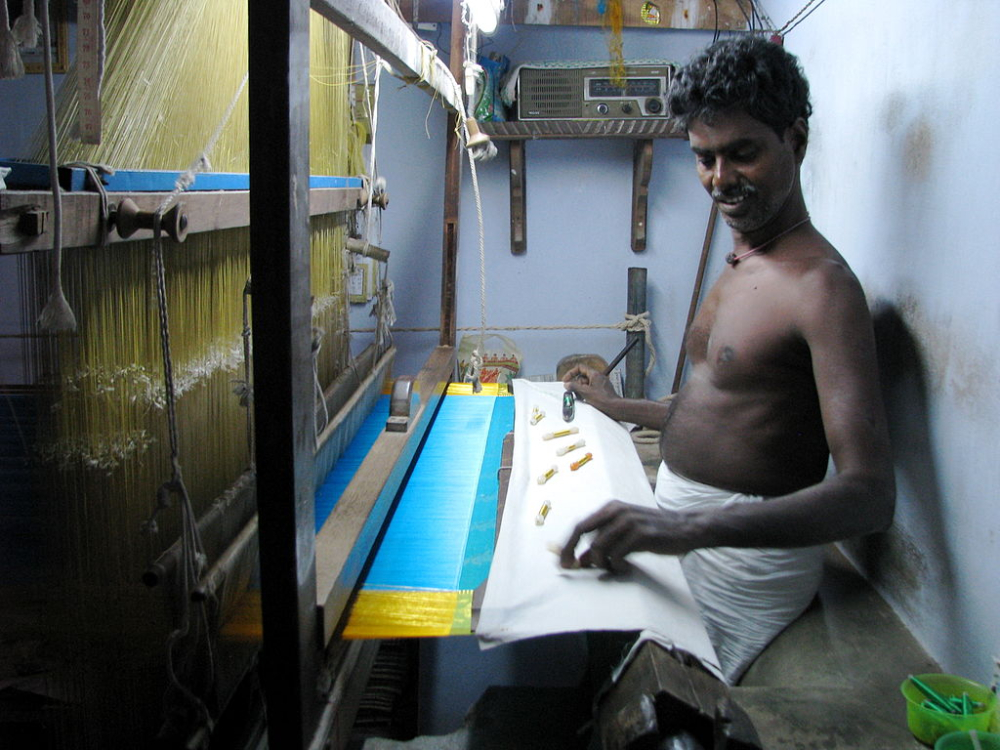India has hundreds of weaver communities such as the Julaha, Ansari and the Kashmiri Kani weavers who have kept the weaving traditions alive for centuries. Here, we look at some of the dedicated weaver communities of India, whose lives are intertwined in the very patterns they create. (Photo Courtesy: Biswarup Ganguly [CC BY 3.0])
It is a well-known fact that India has a rich handloom industry. From the Kashmiri Kani and the Kasavu of Kerala to the Gujarati Patola and the Manipuri Phanek, India is home to many handloom traditions. These colourful, handwoven fabrics are not only an integral part of our heritage but have contributed extensively to the lives of the people engaged in their creation. Historically, these communities have dedicated themselves to weaving, and their livelihoods are intertwined in the very patterns they create. We look at some of India’s prominent weaver communities.
Julaha
This community derives its name from the Persian julah, meaning a ball of thread. Many Julahas associate the words jaal (net) and jils (decorated) with the name of their community. These artisans are known to incorporate bold colours into their weaves. Mostly spread across Punjab, Haryana and Delhi, the Julaha community can also be found in parts of Rajasthan, Uttar Pradesh, Uttarakhand, Himachal Pradesh, Jharkhand, Bihar, Jammu and Kashmir and Maharashtra. In fact, ‘Julaha’ is often used as an umbrella term for weavers in general. Most of them are Hindus, although some Muslim Julaha communities, such as Ansaris or Nurbafs, also exist. Punjab and Chandigarh are populated by Julahas who follow Sikhism (called Ramdasis), and many are animists who worship their ancestors. Regardless of their different religious associations, most Julahas are followers of Kabir and a few have even embraced Buddhism.
Also Read | Textile Production Among the Nomadic Pastoralists of Ladakh
Ansari
The Ansaris trace their history back to the Hijri, when the Prophet Mohammed migrated from Mecca to Medina. Ansari literally means ‘supporter’ and, as the name suggests, they helped the Prophet during his travels. Also known as Momins in Maharashtra, Ansaris are found throughout South Asia, especially northern and western India (with Varanasi as their centre), Sindh in Pakistan and the Terai in Nepal. Although the Ansaris are primarily an Urdu-speaking community, these craftsmen also speak the local dialects or a mixture of the two—for instance, the Ansaris in Rajasthan speak Madri, a curious mix of Urdu and Hindi.
Primarily an urban community today, most Ansaris are politically active in Bihar and enjoy great social and financial mobility. On the other hand, many still work as unskilled labour, manufacturing bidis for a living. In Rajasthan, Gujarat and Maharashtra, they are engaged in weaving gold and silver zari. They also excel in weaving the famous Banarasi brocade and have been given Geographical Indicator (GI) rights to safeguard their interests.
Salvi
Deriving its name from the word sal or ‘loom’, the Salvis are also known as the Patiwala or Patua community. Primarily found in Rajasthan and Gujarat, the Salvis are recognised as the creators of the famous Patan Patola weave. This complex textile combines the processes of tie-and-dye with weaving to produce the Ikat textile. The community is particularly well known for making an indigenous variant of the complicated double Ikat, in which the warp and weft are tied and then resist-dyed before being put on the loom.
Like the Ansaris, the Salvis too have been given GI rights for the Patan Patola. This endeavour has not only made it easier for the original product (made with 8-ply silk in Patan) to be distinguished from its copies, but has also encouraged the community to strive to retain its handloom traditions.
The Salvi community is particularly well known for making an indigenous variant of the complicated double Ikat, in which the warp and weft are tied and then resist-dyed before being put on the loom (Courtesy: Biswarup Ganguly [CC BY 3.0])
Panika
Also known as Panka and Panikar, the Panikas is a community of Hindu weavers based in Chhattisgarh, Jharkhand, Madhya Pradesh, Odisha and Uttar Pradesh. A socially and economically backward community, they are known to be Kabirpanthis and even Shakta worshippers. Their sole means of sustenance is the Pata, a thick cloth made of handspun cotton. However, over the decades they have also developed a unique weave that combines cotton and silk. They use only natural dyes, usually made from the roots of the aal tree (Indian mulberry) in shades that range from deep reds to dark browns.
Their designs are influenced by the tribal customs of the Odisha–Chhattisgarh region.
Also Read | The Sambalpuri Ikat of Odisha: history Symbolism and Contemporary Trends
Devanga
Primarily based in the southern regions of Tamil Nadu, Karnataka and Andhra Pradesh, the Devanga community is known for its super-fine cotton textiles. Members of this caste claim to have descended from the sage, Devala. In Hindu mythology, Devala Maharishi was supposedly the first to weave cotton cloth and present it to Lord Shiva. A part of the community that lives in Chhattisgarh is also said to have originally woven various textiles from Kosa silk, now mostly made in Champa.
Traditionally, men are engaged in weaving while women are involved in dyeing yarn and spinning thread. Their weaves are mainly used by lower-caste communities and the tribes of the region.
Padmashali
The Padmashali community is identified by different names in various regions of India. The name Padmashali comes from two words—padma, meaning ‘lotus’, and shali, meaning both ‘weaver’ and ‘spider’. This Telugu-speaking Hindu community is largely found in Andhra Pradesh. Originally a sub-caste of the Devanga community, the Padmashalis split from the Devangas due to religious differences—the Devanga community follows Shiva while the Padmashalis follow Vishnu.
The community claims to be descended from Rishi Markandeya. According to a Hindu legend, Markandeya supposedly wove the first fabric from the fibres of the lotus flower to clothe the gods.
Currently, the Padmashali community and its various sub-categories weave cloths using materials ranging from cotton to silk.

The name of the Padmashali community of weavers comes from two words—padma, meaning ‘lotus’, and shali, meaning both ‘weaver’ and ‘spider’ (Courtesy: Biswarup Ganguly [CC BY 3.0] )
Koshta
Koshta, or Koshti, is a Marathi and Telugu community of Kabirpanthis and Lingayats. Artisans from this community are spread over northern India and the Deccan in the states of Uttar Pradesh, Bihar, Madhya Pradesh, Chhattisgarh, Maharashtra and Andhra Pradesh. They speak a distinct language, with words borrowed from Sanskrit, Marathi, Khariboli, Bundeli, Chhattisgarhi and variants of Hindi.
A sub-caste of the Padmashali and Devanga communities, the Koshtas also claim to be descendants of Rishi Markandeya. They believe that when the gods were pleased with Markandeya for the cloth he produced, he was given the hand of Surya’s daughter in marriage as a reward, with a giant and a tiger as dowry. But the giant was unruly and Markandeya killed him. It was with the bones of the giant that the saint fashioned the first loom.
The Koshtas are famous for their silk-bordered textile—a white cloth with a red silk border.
Kashmir Kani Weavers
The word kani refers to ‘wooden bobbins’ or ‘small sticks’, and corresponds with the intricate and arithmetic-based weave from Kashmir. Kani weaving requires immense skill and patience as the weavers create intricate patterns using meticulous, coded motifs drawn by master craftsmen.
Traditionally, women were not associated with Kani weaving. However, after the introduction of mechanised looms, both young boys and girls have been employed to weave these products.

Also Read | Woven Embroidery: The Brocades of Benaras
Artisans need to be mathematically gifted as Kani weaving follows an arithmetic graph. Traditionally, women were not associated with this craft. However, after the introduction of mechanised looms, both young boys and girls have been employed to weave these products. Since Kani shawls are highly coveted, they have been given a GI status to safeguard not just the weave but the community as well.
While these are some of the main weaver communities of India, this list is by no means exhaustive. Owing to technological advances and growth in literacy, many weavers have either shifted to using power looms or have left the profession entirely. However, the state and central governments have been trying to encourage more and more members of these communities to continue their handloom traditions by creating various avenues for their exposure, including giving them awards for their skills and providing them with GI rights.
This article was also published on The Statesman.












